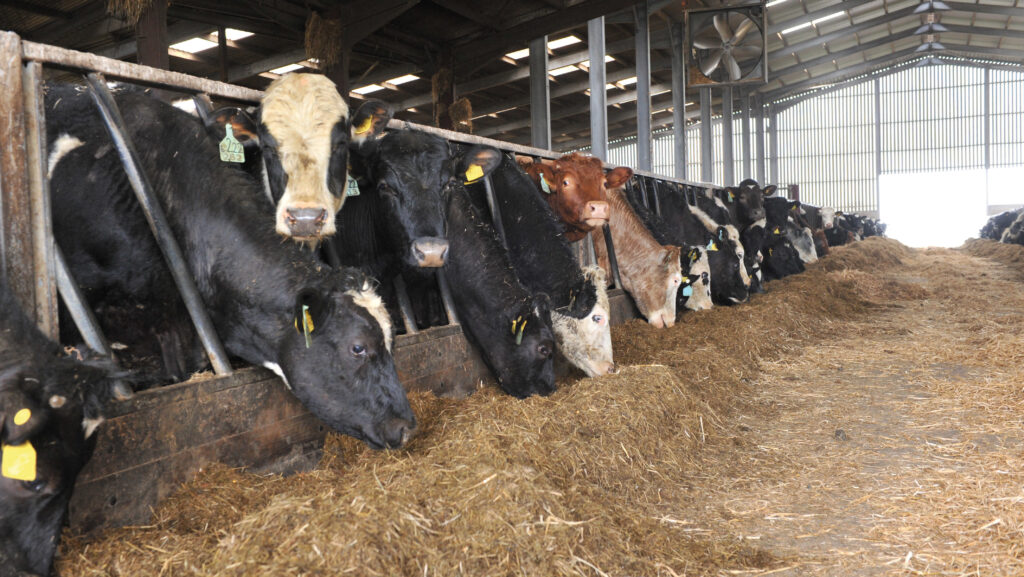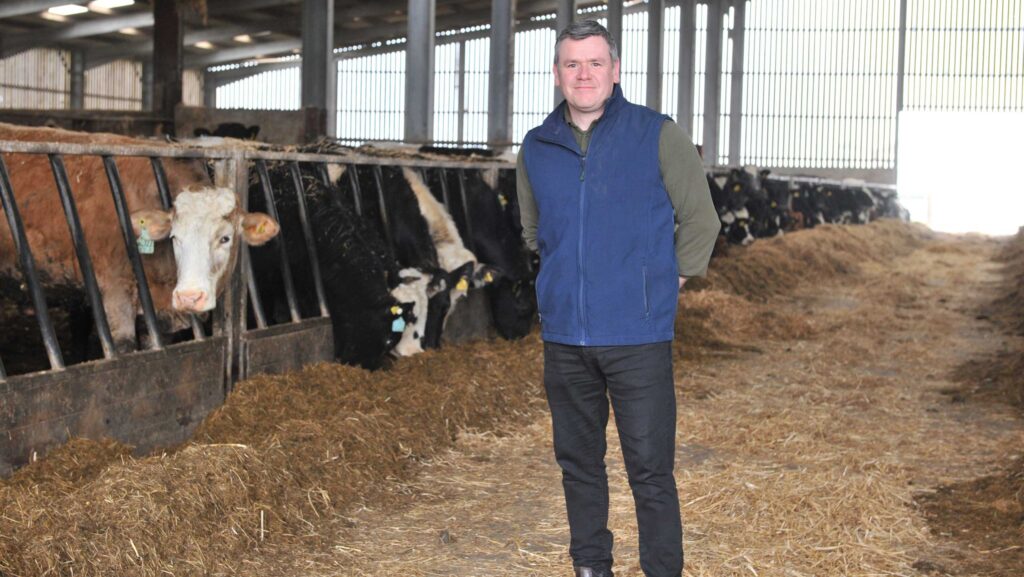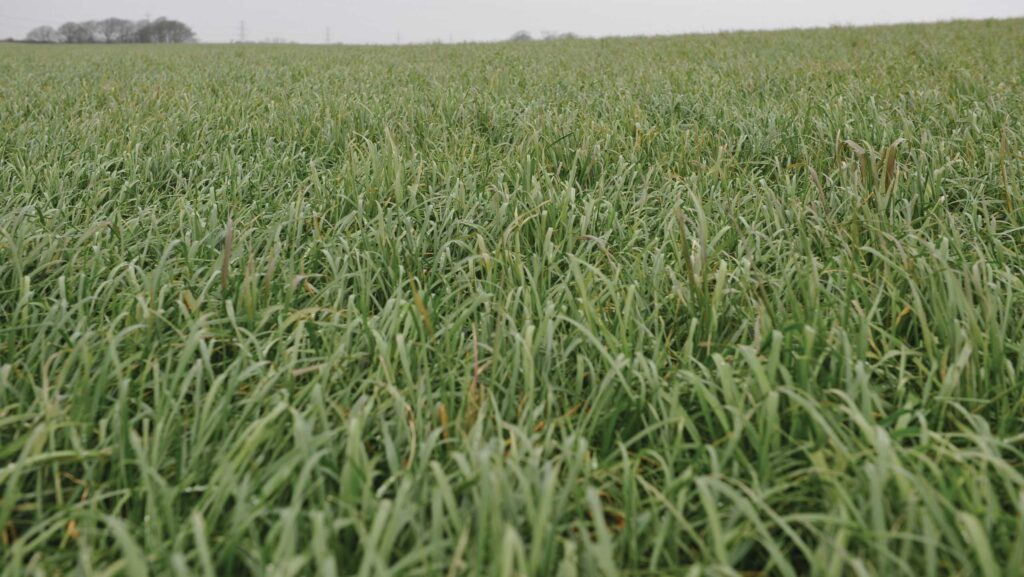How an intensive beef finisher has cut carbon footprint
 © Debbie James
© Debbie James A Welsh beef finisher is demonstrating that making structured progress towards net zero is achievable in an intensive farming system.
Dylan Jones, who farms on Anglesey in partnership with his father, Wyn, has introduced a series of changes that have increased meat production, cut an average of 31 days from the finishing period, made the business entirely self-sufficient in feed, and significantly reduced chemical nitrogen use.
See also: How finishing beef adds value to dairy business
A combination of these measures has enabled their farm, Castellior, to achieve a carbon footprint of 3.9kg carbon dioxide equivalent (CO2e)/kg beef liveweight.
A study published by Bangor University in 2020 put the Welsh national average at 11-16 CO2e/kg liveweight – and that was for non-intensive systems.
Farm facts
- 324ha farmed, mostly owned
- Loamy clay soil
- 45ha winter barley established in September/October
- 89ha spring barley established March/April
- 2,000t of silage harvested annually
- Total mixed ration made up of 7kg crimped barley, 2kg red clover silage, 2kg Westerwold silage, 5kg high-protein silage and 0.5kg straw
- Incoming cattle vaccinated for infectious bovine rhinotracheitis

Dylan Jones © Debbie James
Achieving this has involved a complete revamp of the system the Joneses had in place in 2016.
At that point, they were finishing 700 cattle a year and lambing 900 Suffolk Mules. They would grow 51ha (125 acres) of barley and buy in the remainder of the feed for the total mixed ration (TMR).
Fast-forward eight years, and the breeding ewes have been sold to free up land to increase barley acreage to 134ha (331 acres) and 1,500 cattle are finished annually. In addition, short-term grass leys are reseeded with red clover, making the business much less reliant on bagged N.
Prompt to change
That journey started with a comment made by a group of farmers visiting Castellior, questioning whether such an intensive system could ever reach net zero.
“It was the prompt I needed for making changes,” Dylan recalls. “I could see that the public’s expectations on environmental standards in food production were changing. It was something I knew I had to tackle.”
He says the system they had in place was “a long way from hitting net zero” and reckons the farm’s carbon footprint at that time would have been in the mid- to high teens.
However, he had a clear vision of how he could make progress, with the sale of the breeding ewes the first step. “If I was going to make the farm self-sufficient in feed, I had to forfeit the sheep.”
More cattle, fewer sheep
Sheep have not been removed from the farm entirely, as some are needed as a winter grazing tool.
Up to 600 ewe lambs are bought annually in the autumn and sold as yearlings the following spring. They are shorn twice, with the wool composted and incorporated into the soil with farmyard manure to provide additional nutrients.
The sale of the breeding flock left a gap in annual output of 1,500 fat lambs, so cattle numbers were increased to generate income and provide manure to replace purchased N.
Dairy-cross stores are bought at 18-24 months from auctions and from private sales across north Wales, with 1,500 a year finished.
“By selling the sheep and increasing cattle numbers, we have doubled our output of meat per hectare and, therefore, our efficiency,” says Dylan.
Daily liveweight gain
The number of days to slaughter has fallen from 130 to 99, with an average daily liveweight gain of 1.7kg targeted.
This has been achieved through measures including weekly weighing of 150 cattle and the use of technology to monitor growth.
Using electronic weigh scales linked to an app provides Dylan with a graph charting the performance of every steer. If the data show that an animal is failing to hit target, it is sold.
Dylan supplies his buyer, ABP, with 120-150 cattle a month at a liveweight of 620-630kg to produce a 310-320kg carcass.
Red clover
As well as genetics and cattle health, the quality of feed that goes into the TMR is critical to performance.
As well as growing barley and 10ha (25 acres) of peas, Dylan has switched from a seven-year grass reseeding rotation to a two- or three-year one, growing vigorous red clover, Westerwolds and hybrids.
“If I could choose one plant to credit for where we are today with our carbon footprint, it is red clover. It is an absolutely monster of a crop that helps us work towards our goals, and it has allowed us to halve our N use,” he says.
“We plant it with everything – even undersowing the barley.”

© Debbie James
He benchmarks the leys by weighing the cattle before they are turned into a field, and again when they have finished grazing it.
Although he runs a housed system, 160 of his growing cattle graze from April until October and are then housed at 450kg.
The data provide him with information on the best-performing varieties. “It is not the amount you spend on grass seed, it is how animals perform on them,” Dylan reasons.
He operates a multicut silage system, taking five cuts a year, with the first in mid-March.
The first three cuts are grown without chemical nitrogen; 120kg/ha is applied to the leys for subsequent cuts.
In 2023, first-cut grass silage analysed at 10.7MJ/kg metabolisable energy and 14.9% crude protein.
Soil organic matter
Crops are mainly established through ploughing.
Although Dylan accepts this releases carbon emissions into the atmosphere, he says the effect must be balanced with the ability of ploughing to deliver several benefits – such as enabling him to incorporate 30-37t/ha of farmyard manure into the soil.
He suggests it would be impossible to achieve this if he was establishing barley using min-till or no-till.
“The roots need to get deep down into the soil, and incorporating manure will help that,” he says.
All work is done in-house, with no contractors used. “We need the best forage possible, so I like having control over that,” he says.
Crimping allows the cereals to be harvested up to three weeks early.
Plans for further efficiencies
Despite the many changes he has already made, Dylan constantly keeps one eye on other possibilities.
He plans to introduce hay to add roughage to the TMR and is exploring other ways to make the feed mix more efficient.
The system he has now is very different to the one he had in place in 2016. Funding for the farm’s carbon audit in 2022, available in his role as a Farming Connect focus farm, has demonstrated how well his system compares with others.
“Making that phone call to Farming Connect and becoming a focus farm was a key moment – I threw myself in at the deep end when I made that call, so I had to start swimming,” he says.
He is now involved in the Our Farms Network in the current Farming Connect programme to showcase how his system has developed further since that initial project work.
Discover more at Transition Live
Managing your carbon footprint will be on the agenda at Transition Live on Thursday 9 May in Cambridge. The one-day event aims to tackle the big questions behind how farm businesses produce food sustainably while securing their own future.
Hear from the experts, share ideas and get inspiration from practical on-farm examples to help you succeed in a post-BPS world.
To book tickets, visit the Transition Live webpage.
